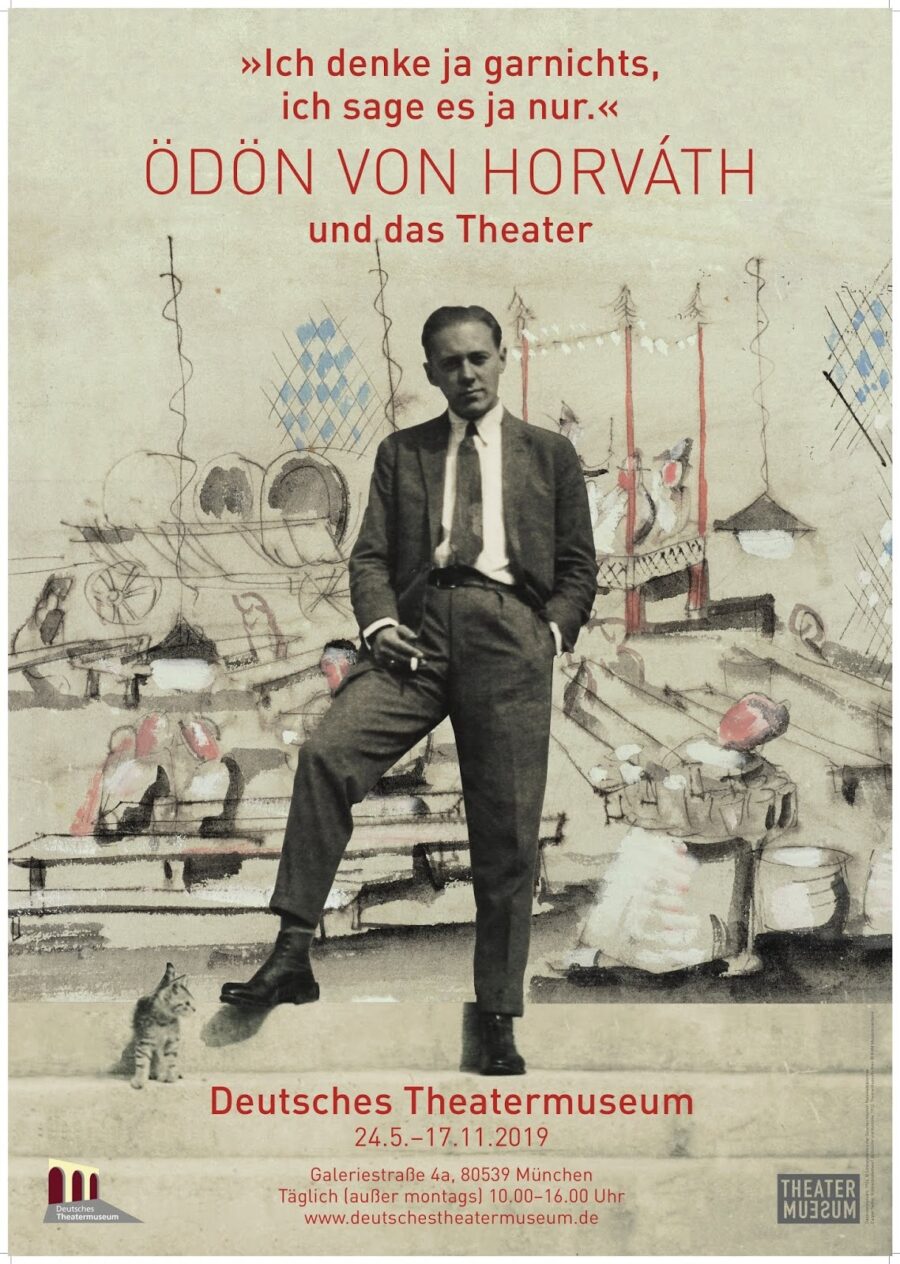May 24, 2019 - Nov 17, 2019
Ödön von Horváth
and the theatre

Copyright: Gerhard Spring
Ödön von Horváth saw himself as a "chronicler of his time" and worked on a constant "demasking of consciousness" through literature.
Through his penetration of petty-bourgeois language, succinctly encapsulated in the term "educational jargon," his concise critique of language, and his "crazy sentences" (Peter Handke), he had a stylistic influence on German-language literature after 1945. Authors such as Peter Handke, Peter Turrini, Wolfgang Bauer, Franz Xaver Kroetz, Werner Schwab, Elfriede Jelinek, Felix Mitterer, Dea Loher, and René Pollesch clearly follow in Horváth's dramatic tradition.
Today, Ödön von Horváth is among the most performed playwrights on German-language stages. Plays such as Italienische Nacht, Geschichten aus dem Wiener Wald (both 1931), and Kasimir und Karoline (1932) were celebrated as a renewal of the folk play during the author’s lifetime.
He repeatedly attempted to view societal structures "from the perspective of women," creating his famous female characters such as Marianne, Karoline, and Elisabeth. With plays like Sladek, der schwarze Reichswehrmann (1929) and Italienische Nacht (1931), he positioned himself distinctly against the rising National Socialism and the threats to the still-young Weimar Republic. After receiving the prestigious Kleist Prize in 1931 for Geschichten aus dem Wiener Wald, he himself became a target of National Socialist agitation. The seizure of power by the Nazis in Germany meant a sudden end to his promising career as a playwright. His plays were no longer performed in the Reich, and planned premieres were cancelled, forcing him to work as a screenwriter in the Reich's film industry. The experiences he gained during this period led to his radical disavowal of the German Reich under the National Socialists.
With plays like Mit dem Kopf durch die Wand (1935), Figaro läßt sich scheiden, and Don Juan kommt aus dem Krieg (both 1936), he redefined his position as a writer. His novels Jugend ohne Gott (1937) and Ein Kind unserer Zeit (1938) established him as a pronounced anti-fascist author. In particular, Jugend ohne Gott remains part of the canon of German-language literature and is a classic of school reading lists.
The exhibition runs along three central plays, each dedicated to a specific area and an overarching theme: Economy, Eroticism, and Politics.
In addition, insights into the creation and reception of the plays are provided.
In the entrance area and the stairwell, essential aspects of Horváth's biography and work—such as death, "silence," the user manual, and the author's working methods—are presented.
The first section focused on a drama addresses the topos of Politics in Ödön von Horváth's work and biography, starting from Italienische Nacht. Here, one finds themselves in a tavern hall after the "hall battle" between different political factions, as Horváth presciently portrayed in Italienische Nacht and experienced himself in Murnau. This not only reconstructs the political climate of the Weimar Republic but also highlights Horváth's own entanglements with the Nazi regime and his purification with the late pacifist and anti-fascist novels Jugend ohne Gott (1937) and Ein Kind unserer Zeit (1938).
The large upper hall presents the stylised atmosphere of the Oktoberfest in Kasimir und Karoline and the omnipresent eroticism in Horváth's work. As if in a funfair, one encounters locations such as the Temple of Venus, the autodrome, and the panorama. Special attention is given to the intersections of eroticism with the economy. The space culminates in a reflection on the various aspects of gender relations in Horváth's work. Here, depictions of women and men, as well as contemporary relationship forms, are presented.
Finally, one arrives at Geschichten aus dem Wiener Wald, which is organised around the topos of the economy. In "Oskar's respectable butcher's shop," various facets of the "quiet street" are exposed, such as the middle class and its economic and political constitution, the woman as a commodity, and the man as a butcher, alongside Horváth's treatment of the Vienna cliché.
In this elaborately staged exhibition, the political substance and pressing relevance of Horváth's drama are clearly demonstrated through various objects, documents, audio, and video examples from 40 lending institutions and private individuals.
The exhibition was curated by Nicole Streitler-Kastberger and Martin Vejvar and designed by Peter Karlhuber.
NICOLE STREITLER-KASTBERGER is a literary scholar, literary critic, and author; since 2005, she has been a research associate at the Vienna edition of all works by Ödön von Horváth.
MARTIN VEJVAR has been a research associate at the Vienna edition of all works by Ödön von Horváth since 2008; he is the editor of several volumes.
PETER KARLHUBER is a set designer and exhibition designer. He previously designed the exhibition "Frank Wedekind. Theatre – Eros – Provocation" for the Deutsches Theatermuseum in 2014/15. In 2015, he worked on "We Need a Completely Different Kind of Courage! Stefan Zweig – Farewell to Europe" at the Literaturhaus München.
Publication for the exhibition:
"I don’t think anything, I just say it." - Ödön von Horváth. Eroticism, Economy, and Politics
Edited by Nicole Streitler-Kastberger and Martin Vejvar, published in 2018 by Verlag Jung und Jung, Salzburg
€35.00
The contributions in this richly illustrated volume span a thematic arc from theatre aesthetics and performance practices to questions of gender difference and the socio-economic, historical, and political positioning of Horváth's texts. The scholarly contributions are supplemented by essays and literary texts by Wolfgang Müller-Funk, Gerhild Steinbuch, Fiston Mwanza Mujila, Ferdinand Schmalz, Peter Turrini, and Ödön von Horváth.
The exhibition premiered at the Theatre Museum Vienna on 15 March 2018.
We look forward to collaborating with the following institutions:



